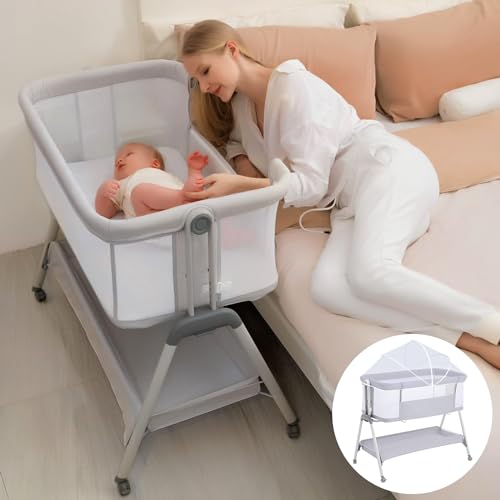10 Unexpected Bedside Cot For Healthy Sleeping Tips

The Benefits of Using a Bedside Cot for Healthy Sleeping: A Comprehensive Guide
When it pertains to making sure a healthy sleep environment for infants and their caregivers, the option of sleeping arrangements plays a crucial function. One popular option that has actually acquired considerable attention recently is the bedside cot. This ingenious furniture piece not only maximizes safety however likewise promotes bonding between parent and child during the early months. This short article explores the numerous advantages of bedside cots, necessary functions to consider, and answers often asked concerns.
Comprehending Bedside Cots
A bedside cot, likewise known as a co-sleeper or sidecar crib, is a small crib that attaches straight to the side of an adult bed. This design allows parents to keep their baby close while supplying a safe sleeping environment different from the adult bed.
Secret Features of Bedside Cots
- Adjustable Height: Bedside cots generally feature adjustable legs, allowing them to match the height of the parents' bed.
- Breathable Mesh Sides: Many models integrate breathable mesh material, ensuring proper air circulation and permitting parents to monitor their baby quickly.
- Protect Attachment: Bedside cots attach firmly to the adult bed, minimizing the risk of the baby rolling off or getting trapped.
- Portable Design: Many bedside cots are light-weight and collapsible, making them easy to transfer for travel.
Benefits of a Bedside Cot
Using a bedside cot offers numerous benefits for both parents and infants. Below are some of the primary advantages of this sleeping plan:
1. Improved Bonding
Having a baby sleep near their parents can cultivate a strong psychological bond. Parents can quickly address their child's requirements throughout the night, promoting security and attachment. Bedside Cot For Modern Nursery benefit from the noise of their parent's heartbeat and voice, which can relieve them and help them go to sleep more quickly.
2. Breastfeeding Convenience
For breastfeeding mothers, bedside cots supply immediate access to the baby during the night. This convenience can help with midnight feedings, decrease sleep disruption, and enable a smoother breastfeeding experience.
3. Enhanced Sleep for Parents
With the baby close by, parents can rest easier knowing they can rapidly respond to any sounds or movements. Research studies have revealed that parents with a bedside cot typically experience better sleep, as they can maintain a level of awareness without completely awakening.
4. Motivation of Safe Sleep Practices
Bedside cots strengthen the principles of safe sleep by providing a separate sleeping space for the baby. The American Academy of Pediatrics advises a different sleeping surface area to decrease the danger of Sudden Infant Death Syndrome (SIDS). A bedside cot permits parents to comply with these standards without sacrificing distance.
5. Versatility and Portability
Many bedside cots are developed to be versatile and easy to move. This mobility can make transitioning from home to travel a breeze, guaranteeing the baby constantly has a familiar sleeping environment.
Aspects to Consider When Choosing a Bedside Cot
When choosing a bedside cot, parents must think about numerous essential elements to assess the very best option for their family's needs.
| Element | Description |
|---|---|
| Size | Make sure the cot is appropriately sized for your space. |
| Security Standards | Try to find models that abide by current safety regulations. |
| Reduce of Attachment | Ensure it can firmly connect to your bed. |
| Material Quality | Choose breathable, non-toxic materials for your baby's health. |
| Mobility | Consider whether you require a cot that is easily transportable. |
| Price | Set a budget, as rates can vary considerably. |
Frequently Asked Questions: Bedside Cot for Healthy Sleeping
1. Are bedside cots safe for sleeping?
Yes, when used according to maker guidelines and safety standards, bedside cots provide a safe sleeping space for infants. They help reduce the danger of SIDS by ensuring the baby sleeps separately but within close reach of the parents.
2. At what age can a baby start utilizing a bedside cot?
Most bedside cots are suitable for infants from birth approximately around 6 months or until they begin to roll over and move individually. Always consult the producer guidelines for particular age suggestions.
3. Can I use a bedside cot for twins?
While lots of bedside cots are designed for a single infant, there are alternatives on the market particularly designed for twins. Research and pick a model that provides safety and space for both babies.
4. What are the options to a bedside cot?
Other sleeping arrangements consist of conventional cribs placed in the exact same room, bassinettes, and co-sleepers designed for safe bed-sharing. Each has its pros and cons depending on the parents' choices and living scenario.
5. How do I guarantee the attachment of the bedside cot is safe?
Before utilizing the cot, examine the attachment mechanism and guarantee it is tightened properly. Regularly inspect the connection to guarantee it stays protected, specifically as the infant grows and moves.
Picking a bedside cot can be a wise decision for new parents seeking a balance in between their baby's security and the comfort of close proximity. The benefits of boosted bonding, breastfeeding convenience, improved sleep for parents, and the promo of safe sleep practices highlight its growing popularity. By carefully thinking about the necessary features and safety guidelines, parents can provide a nurturing sleep environment that cultivates health for both themselves and their babies. With the right bedside cot, everyone can take pleasure in a peaceful and satisfying night's sleep.

